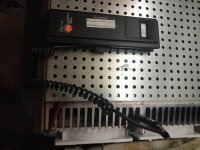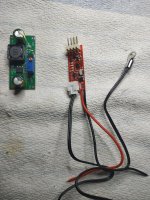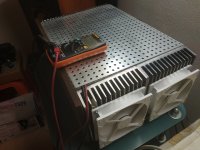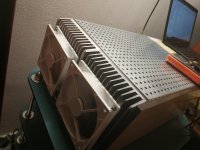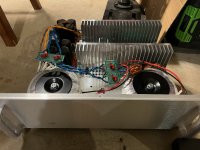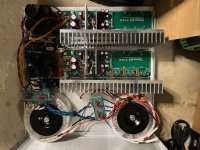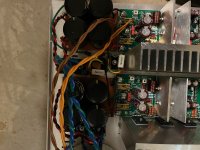That what I'm counting on. To perfect the "nextgen". Thanks.Its all been tested and varied many times.
I want to beat the Halcro... got it.
OS
At this point ....""never got over 90 farenheight just barely warm to touch after 3 hours running at about 50 percent.""Thank you Stuart I did install the updated condiguration and associated parts.I did try a few different gain level parts on q103 and it seems to fovor the higher HFE parts the bd136-16 were showing HFE of 155 and when i ran it with that part it tracked temp very nicely never got over 90 farenheight just barely warm to touch after 3 hours running at about 50 percent. I am happy with that
Did you measure the quiescent current again?
(Correct repetition) post 2.740
I put these pwm fans controlled by a processor over the heatsinks and reduce the temp so I can get a constant 38C over the heatsinks. However, the quiescent current after an hour drops from 44mv to 38 to 40mv and the heatsink temperature remains constant at 38 degrees. I play music at high volume. Is the temperature trapped inside the box to blame? Can someone explain the quiescent current mechanism and the role of transistor Q103 and Q104.
maybe they need small changes in the resistors depending on the situation??
I put these pwm fans controlled by a processor over the heatsinks and reduce the temp so I can get a constant 38C over the heatsinks. However, the quiescent current after an hour drops from 44mv to 38 to 40mv and the heatsink temperature remains constant at 38 degrees. I play music at high volume. Is the temperature trapped inside the box to blame? Can someone explain the quiescent current mechanism and the role of transistor Q103 and Q104.
maybe they need small changes in the resistors depending on the situation??
Attachments
@Nikos
Well, heat transfer isn't instantaneous. It takes time to approach steady state. Adjust your Ic after the temperature stabilizes and re-adjust it later, if necessary.
Well, heat transfer isn't instantaneous. It takes time to approach steady state. Adjust your Ic after the temperature stabilizes and re-adjust it later, if necessary.
The bias is responding normally to the increase in ambient temperature inside the amp chassis. A decrease of 4mV is nothing to worry about. It takes well over an hour almost 2 hours for the amp to stabilize temperature. The build guide recommends adjusting the bias after its warmed up for this reason. Put the lid on and turn it on for a couple hours, and adjust it from there.
Hi Nikos,
You don't need the fans or the temperature controller the temperature will increase and decrease with signal level.
The Vbe multiplier circuit controls the bias for you.
During burn in take some more time to allow the amplifier to be at a stable temperature before setting 44 mV
I hope this helps - Andy's post above is right about the time required being a couple of hours
- Dan
You don't need the fans or the temperature controller the temperature will increase and decrease with signal level.
The Vbe multiplier circuit controls the bias for you.
During burn in take some more time to allow the amplifier to be at a stable temperature before setting 44 mV
I hope this helps - Andy's post above is right about the time required being a couple of hours
- Dan
Thank you for your replies.
Μy heatsinks 28 Χ 15.5 Χ 4 cm are kind of small, that's why I added the fans for uninterrupted hard operation of the amplifier.
I didn't think it would take two whole hours for the temperature to stabilize... I have adjusted the quiescent current after half an hour... so it is correct to adjust the quiescent current after two hours of operation of the amplifier in a quiescent state?
Μy heatsinks 28 Χ 15.5 Χ 4 cm are kind of small, that's why I added the fans for uninterrupted hard operation of the amplifier.
I didn't think it would take two whole hours for the temperature to stabilize... I have adjusted the quiescent current after half an hour... so it is correct to adjust the quiescent current after two hours of operation of the amplifier in a quiescent state?
Last edited:
everything has to be at thermal equilibrium to set it. Lid on but not screwed. Do you have a graphing multimeter? Hook it up and see for yourself. 30 minutes is not even close to long enough.
I am very close to completing my build as i have worked on soft start and dc protection boards i have played many CDs and all i can say is WOW . I Want to extend my Thanks To EVERYONE who worked to make this incredible Amplifier what it is . I have not heard any other amplifier in my 59 Years this dynamic and incredibly lifelike sounding. My Focal Chora towers are picky and hard to drive properly with 70 degree phase angle . This Amplifier makes them sing like no other THANK YOU FOR YOUR TIME YOUR TALENTS AND PATIENCE
Last edited:
No i have not since i finished mounting them all of the voltages were good from day 1 i just wanted to see if it changed the bias one way or the other with different gain level parts i am very happy with the way it has behaved dc offset is very stable barely had to turn r25 . Tp 3 and 4 were spot on at 620 mV and i got 1.4 an1.42 volts on main board test points only took few turns to set bias at 40 mV TP101 102 this amp is very well behaved i am thrilled they did Great job on BOM no other DIY project i have seen has had such support of very talented people We are Blessed with their ContributionsAt this point ....""never got over 90 farenheight just barely warm to touch after 3 hours running at about 50 percent.""
Did you measure the quiescent current again?
While we're on heat transfer and the Q103 topic, Here's my **** up on my latest EF3-4 build (currently have an EF3-3 build working fine) for others to look out for:
I got through all the testing stages with no outputs installed fine, Using a bench variac on a quick single bridge and 2x smoothing caps DC supply for testing up to 70VDC
1. I then installed the outputs and the assembly onto the heatsink - Keep in mind my Q103 location - it was as per the latest build guide in the preferred location which is between the drivers (which are also) on the main heatsink, in the tri-arrangement under the PCB, mounted parallel with the main heatsink. Exactly as @danieljw had pictured on the previous page in other words. My heatsinks were bare so I drilled and tapped all the output, standoff and driver/q103 holes myself
2. I installed 2A fuses to begin the next round of testing, and all tests passed. However my first mistake was not letting the amp sit for long enough here with the bias turned up to spec. I checked it got to spec and then wound it back down to proceed to the next step
The next 3 steps happened fast so keep in mind;
3. I installed 8A fuses and began final biasing. Watching the bias voltage like a hawk, I noticed it got up to spec after turning R109 up a bit, and then after 5 2-3 minutes (all while slowly turning the R109 back down as the amp warms up) started to slowly drop, which I thought is not normal. I suddenly tried winding R109 up to counter it. Little did I know the heatsinks and outputs were getting hot at this point.
4. The bias voltage plummeted - I didn't realize at the time it was (I think) Q103 finally getting some heat and trying to crash the bias but it was too late.
5. An 8 amp rail fuse blew, I immediately A-Z5'd the amp. 2 of the outputs were extremely hot, Later found I lost 2x PNP outputs.
6. I checked the other channel - observed similar behavior, but this time with current meters on the rails I managed to shut off the amp when the current started to peg (normally about 350-400mA per channel idle I believe), this was shooting up toward 1 amp (as high as the meter goes) before I shut it down and felt the heatsink, also extremely hot.
7. Spent a day checking my work thinking I had a component in backwards somewhere or a resistor off by a factor of 10 or something
8. My face when I realize the one hole, on both heatsinks, that I had forgotten to debur after tapping, was for Q103. So even though Q103 had thermal paste on it, it wasn't screwing down flush to the heatsink. It would have been 0.2-0.4mm proud of the heatsink. Thermal runaway, (me being cheap and using boron in the control rods jk/not being thorough enough)
There you have it folks, dont be like me, check all your heatsink holes are clean, and free of burrs. All transistors need good flush contact with their heatsinks!
I got through all the testing stages with no outputs installed fine, Using a bench variac on a quick single bridge and 2x smoothing caps DC supply for testing up to 70VDC
1. I then installed the outputs and the assembly onto the heatsink - Keep in mind my Q103 location - it was as per the latest build guide in the preferred location which is between the drivers (which are also) on the main heatsink, in the tri-arrangement under the PCB, mounted parallel with the main heatsink. Exactly as @danieljw had pictured on the previous page in other words. My heatsinks were bare so I drilled and tapped all the output, standoff and driver/q103 holes myself
2. I installed 2A fuses to begin the next round of testing, and all tests passed. However my first mistake was not letting the amp sit for long enough here with the bias turned up to spec. I checked it got to spec and then wound it back down to proceed to the next step
The next 3 steps happened fast so keep in mind;
3. I installed 8A fuses and began final biasing. Watching the bias voltage like a hawk, I noticed it got up to spec after turning R109 up a bit, and then after 5 2-3 minutes (all while slowly turning the R109 back down as the amp warms up) started to slowly drop, which I thought is not normal. I suddenly tried winding R109 up to counter it. Little did I know the heatsinks and outputs were getting hot at this point.
4. The bias voltage plummeted - I didn't realize at the time it was (I think) Q103 finally getting some heat and trying to crash the bias but it was too late.
5. An 8 amp rail fuse blew, I immediately A-Z5'd the amp. 2 of the outputs were extremely hot, Later found I lost 2x PNP outputs.
6. I checked the other channel - observed similar behavior, but this time with current meters on the rails I managed to shut off the amp when the current started to peg (normally about 350-400mA per channel idle I believe), this was shooting up toward 1 amp (as high as the meter goes) before I shut it down and felt the heatsink, also extremely hot.
7. Spent a day checking my work thinking I had a component in backwards somewhere or a resistor off by a factor of 10 or something
8. My face when I realize the one hole, on both heatsinks, that I had forgotten to debur after tapping, was for Q103. So even though Q103 had thermal paste on it, it wasn't screwing down flush to the heatsink. It would have been 0.2-0.4mm proud of the heatsink. Thermal runaway, (me being cheap and using boron in the control rods jk/not being thorough enough)
There you have it folks, dont be like me, check all your heatsink holes are clean, and free of burrs. All transistors need good flush contact with their heatsinks!
No problem it’s all part of the fun 🤣
I'm going to check over the build guide and incorporate a few notes on this as well to ensure ideal transistor mounting conditions are assured.
Quality extruded aluminum heatsink
Alloy: 6063-T6
Width is 10.000" Hight is 4"
Fin Height is 1"
Base Height is .300"
Weight is approximately .50 lbs per inch
C/W/3": approximately .90
www.heatsinkusa.com
Alloy: 6063-T6
Width is 10.000" Hight is 4"
Fin Height is 1"
Base Height is .300"
Weight is approximately .50 lbs per inch
C/W/3": approximately .90
www.heatsinkusa.com
- Home
- Amplifiers
- Solid State
- DIY Class A/B Amp The "Wolverine" build thread
